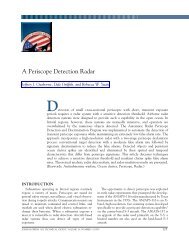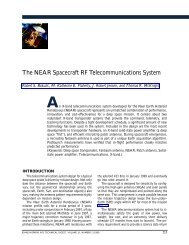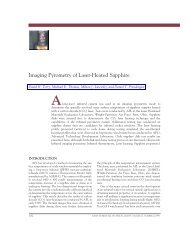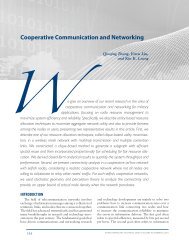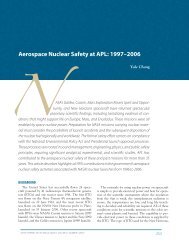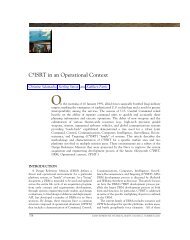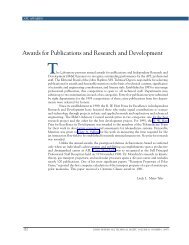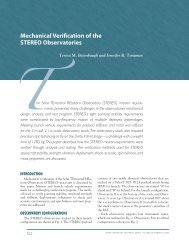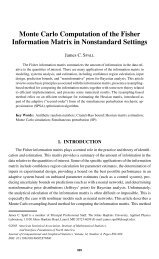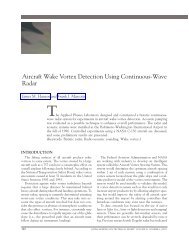Tomahawk Deconfliction - The Johns Hopkins University Applied ...
Tomahawk Deconfliction - The Johns Hopkins University Applied ...
Tomahawk Deconfliction - The Johns Hopkins University Applied ...
You also want an ePaper? Increase the reach of your titles
YUMPU automatically turns print PDFs into web optimized ePapers that Google loves.
A. F. POLLACK, R. C. FERGUSON, AND A. K. CHRYSOSTOMOU<br />
indicated that the automatic offset algorithm assigned<br />
all missiles to unique offsets during the en route portion<br />
of the mission.<br />
In addition to monitoring the effective implementation<br />
of the deconfliction solution in the current system,<br />
APL also evaluates the implications of potential<br />
future developments in the <strong>Tomahawk</strong> missile system.<br />
One improvement being considered is use of GPS after<br />
the missile’s final DSMAC navigation update. Post-<br />
DSMAC use of GPS allows missions to be planned with<br />
longer distances between the final DSMAC scene and<br />
the target by dramatically reducing the effects of the<br />
navigator drift rate. Because the analysis of the probability<br />
of collision includes a component dependent on<br />
both the terminal length and terminal accuracy, post-<br />
DSMAC GPS has the potential to affect the deconfliction<br />
solution. APL determined the changes resulting<br />
from post-DSMAC GPS and input the changes into<br />
the deconfliction simulations to quantify the effect on<br />
the probability of collision. This analysis showed that<br />
despite a small increase, the overall probability of collision<br />
remained within acceptable limits.<br />
Tactical changes can also require deconfliction to be<br />
re-examined. To help reduce the number of missiles on<br />
a common route, the mission planners started to add<br />
altitude offsets to certain missions. A question arose<br />
about whether or not wake effects from the stacked<br />
missiles were a concern. Although aerodynamic effects<br />
were considered during the initial analysis, APL undertook<br />
a more detailed examination to answer the Fleet’s<br />
question. A simulation was developed to determine the<br />
probability of a missile encountering the wake field of<br />
a previous missile. <strong>The</strong>se results were fed into a second<br />
multimissile simulation to determine the overall probability<br />
within the context of a strike. <strong>The</strong> results indicated<br />
that, although a wake encounter is possible, such<br />
encounters are relatively rare. Additional analysis with<br />
a 6 degree-of-freedom simulation further indicated that<br />
the <strong>Tomahawk</strong> missile is capable of recovering from<br />
certain wake encounters. <strong>The</strong> conclusion was that no<br />
additional deconfliction measures were necessary.<br />
As new system modifications occur, APL will continue<br />
its system engineering efforts with regard to<br />
<strong>Tomahawk</strong> deconfliction. System engineering does not<br />
stop with the delivery of the initial solution. As<br />
<strong>Tomahawk</strong> evolves, deconfliction must evolve with it<br />
to assure a low probability of collision.<br />
CONCLUSIONS<br />
<strong>The</strong> Big Sky-Little Missile theory was widely accepted<br />
when APL began its deconfliction analysis. While<br />
initially valid, the theory was based on an earlier system<br />
and needed to change to fit new system developments.<br />
APL’s systematic approach to deconfliction identified<br />
and analyzed the key areas of concern. Many considered<br />
the target area, dense with arriving missiles and explosive<br />
debris, the most likely area for interference, but our<br />
analysis showed such terminal fratricide was not a<br />
major concern. En route interference was considered<br />
unlikely, in part because of the Big Sky Little Missile<br />
theory. Our analysis demonstrated that GPS guidance<br />
significantly reduces the “size of the sky,” leading to<br />
unacceptable probabilities of collision without some<br />
form of deconfliction. After building a consensus within<br />
the <strong>Tomahawk</strong> community supporting the need for<br />
deconfliction, APL took the lead in identifying and<br />
evaluating solutions. Potential solutions ranged from<br />
changes in mission planning to changes in weapon<br />
control to changes in the missile itself. APL’s broad<br />
system perspective enabled us to recommend a solution<br />
from among the diverse set of options. We provided the<br />
analysis to define the details necessary for implementation<br />
and followed the solution through development<br />
and testing all the way into tactical Fleet deployment.<br />
<strong>The</strong> Laboratory’s deconfliction involvement did not<br />
end with delivery of the solution. <strong>Deconfliction</strong> is a<br />
complex system problem. Delivery of the initial solution<br />
to the Fleet was just one step in addressing deconfliction.<br />
As the <strong>Tomahawk</strong> missile system continues to<br />
evolve, APL continues to assess how these changes<br />
affect deconfliction. APL provides continuity and<br />
breadth of knowledge to the <strong>Tomahawk</strong> program that<br />
enable us to identify and track issues, such as deconfliction,<br />
that reflect total system capabilities.<br />
REFERENCES<br />
1 Southwest Research Institute, Building Debris Hazard Prediction Model, Final<br />
Report (Feb 1991).<br />
2 U.S. Department of Commerce, <strong>The</strong> Navstar GPS System, AD-A199 829 (Sep<br />
1988).<br />
3 Critical Item Product Function Specification for the Radar Altimeter, JCM-1962.<br />
88 JOHNS HOPKINS APL TECHNICAL DIGEST, VOLUME 18, NUMBER 1 (1997)



